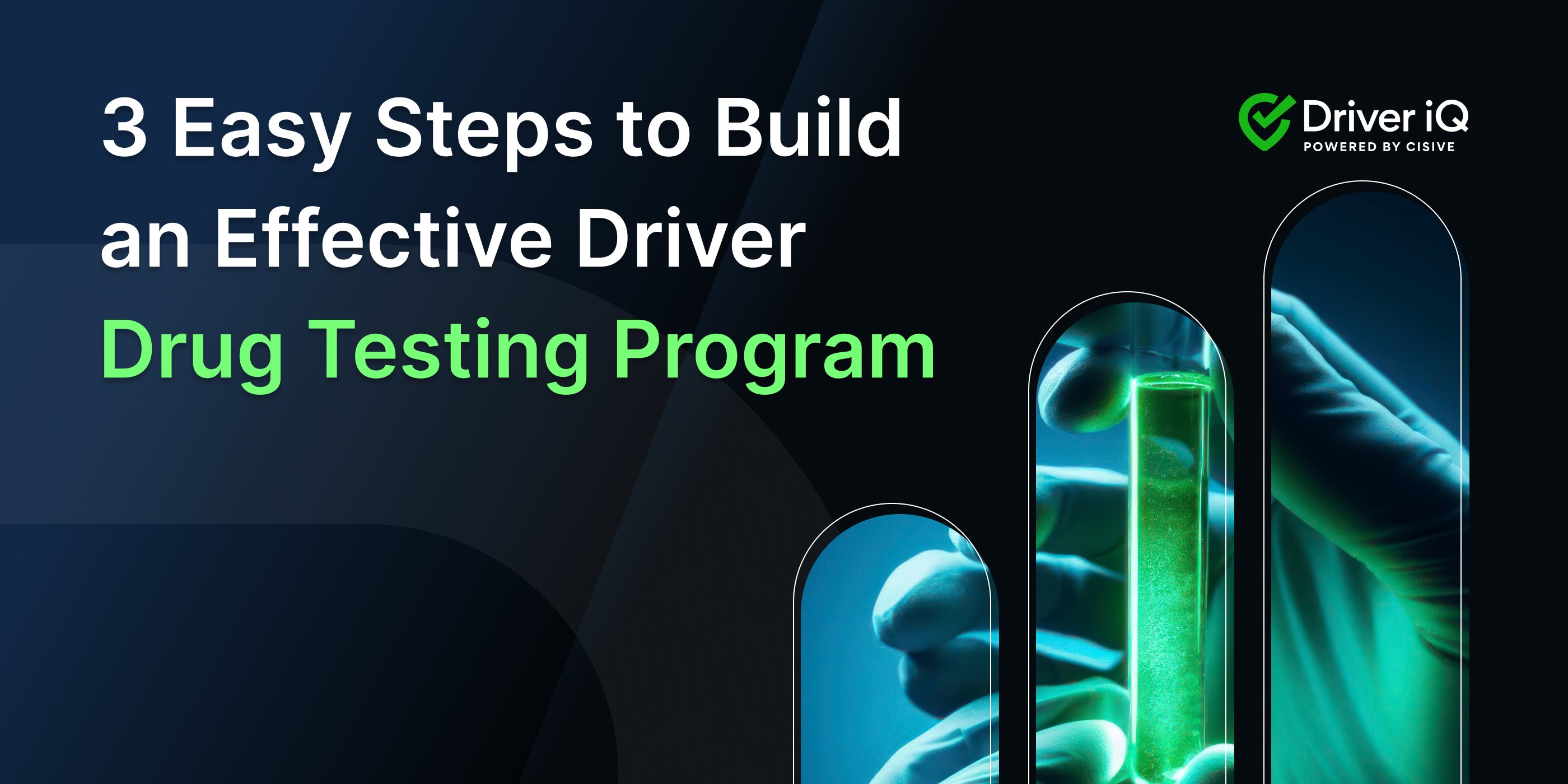

If your company uses drug testing to make hiring and firing decisions, here's what you need to know...

Motor carriers need to hire drivers who are safe and reliable, both for the public’s safety and their business’ reputation. Pre-employment drug and alcohol testing plays a critical role in this process, helping create a safer work environment and comply with laws and regulations.
Explore the importance of these tests, how they’re regulated, and best practices for their implementation and management.
Key Takeaways
|
Table of Contents
Drug and alcohol testing plays a crucial role in the transportation industry for several important reasons, including safety, compliance, and public confidence.
Safety is paramount in the transportation sector. Personnel with substance-use disorders are more likely to operate with impaired judgment, slower reaction times, and diminished motor coordination. They significantly increase the risk of accidents and other incidents.
The consequences can be catastrophic — loss of life, environmental damage, and substantial financial losses due to litigation, compensation, and physical damage. Regular drug testing helps to identify individuals who may be under the influence or have a substance-use problem, helping employers mitigate these risks.
Drug and alcohol testing also contributes to compliance for transportation companies. This industry is heavily regulated, with high safety standards for drivers and other employees. Noncompliance can result in heavy penalties for companies, including fines, suspensions, or license revocation.
Finally, the transportation sector must enjoy public confidence in the safety of transport systems. Rigorous drug and alcohol testing programs allow transportation companies to demonstrate their commitment to safety, which helps their reputation with the public.
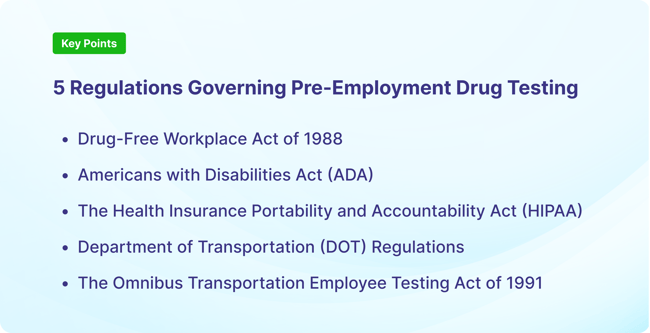
Companies must be aware of and follow applicable regulations when navigating pre-employment drug testing. These rules ensure that testing processes are fair, consistent, and respect people’s rights while prioritizing workplace safety. Let’s look at key regulations that transportation companies must follow when implementing pre-employment drug testing programs.
Drug-Free Workplace Act of 1988: This act requires that any organization receiving federal grants or contracts maintain a drug-free workplace. While the law doesn't mandate drug testing, many employers implement drug testing programs to comply with its other requirements.
Americans with Disabilities Act (ADA): While not a drug-testing law, the ADA has implications for how drug tests are administered and how the results are used. The ADA prohibits discrimination against employees or job applicants with disabilities, including those who are taking medication to treat a disability. This law, however, doesn’t protect people from the consequences of using illegal drugs.
The Health Insurance Portability and Accountability Act (HIPAA): In certain contexts, HIPAA can impact how drug-test results are handled, especially when regarding the disclosure of personal health information.
Department of Transportation (DOT) Regulations: The DOT requires pre-employment drug and alcohol testing in certain situations and for certain sectors. This covers safety-sensitive employees in transportation industries including aviation, trucking, railroads, mass transit, pipelines, and maritime sectors. These requirements are detailed in 49 CFR Part 40 and industry-specific regulations (e.g., the Federal Motor Carrier Safety Administration’s rules for trucking).
The Omnibus Transportation Employee Testing Act of 1991: This federal law requires drug and alcohol testing for safety-sensitive transportation employees in aviation, trucking, railroads, mass transit, and pipelines. It covers random tests and those conducted with reasonable suspicion, as well as pre-employment, post-accident, and return-to-duty testing.
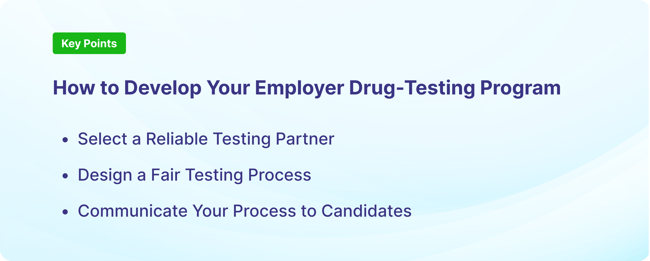
Developing a pre-employment drug testing program requires careful planning and adherence to legal and ethical standards. Consider the following steps for creating a program that is effective and respects job candidates' rights.
Partner with a reputable consortium/third-party administrator (C/TPA), like Cisive or Driver iQ, to manage your pre-employment drug testing program. A reliable partner will connect your candidates with different types of drug tests, provide accurate, timely pre-employment drug screening results, and help you navigate the complexities of compliance.
Cisive has developed strategic alliances with best-in-class providers of drug and alcohol testing, as well as in-house medical review officers, all employing the latest testing technologies. Clients can receive rapid drug-test results in near real time. Other features include paperless drug-test collections, online test scheduling, and notifications for expired events and no-show donors.
Fairness and transparency are key to a successful testing program. Establish consistent criteria for drug testing, and ensure that they follow laws and regulations. Such criteria include which substances you’re testing for, which tests you’re using, and what procedures you’ll follow after positive tests.
Transparency with potential hires is essential. Communicate your drug and alcohol testing policies during the recruitment process. Share which tests are performed, why they're necessary, how results are handled, and how a positive test could affect a conditional offer of employment. This approach respects the candidate's rights and sets expectations from the start.
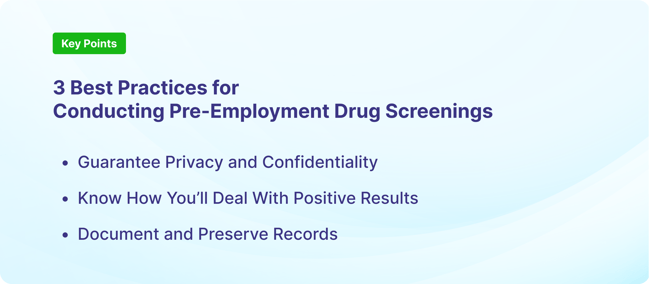
Comprehensive pre-employment drug-testing programs are more successful when companies follow best practices that are consistent and compliant. Here are some guidelines to consider.
Respecting candidates' privacy and confidentiality is a matter of law and ethics. Ensure that test results are securely stored and only shared with authorized personnel. This protects both the candidate and the company and helps to build trust in your testing process.
A positive test result doesn't necessarily mean immediate disqualification. Develop a fair and consistent process for handling these cases. Such a process includes confirming the results with additional testing, providing the candidate with the opportunity to explain, and considering the possibility of rehabilitation and retesting.
Accurate record-keeping is essential for compliance and for protecting your organization in the event of disputes. Document all tests conducted, including the date, type of test, who performed it, and the results. These records should be securely stored and kept confidential, in line with privacy laws and regulations.
A streamlined drug and alcohol testing process is more efficient and more consistent, and supports a better hiring experience. Look at how technology can automatically manage testing schedules, communicate results, and document compliance. Automated systems can reduce errors, ensure timely testing, and save time for employers and candidates.
By understanding the legal requirements, developing a fair and transparent testing program, and adhering to best practices, you can protect your employees, the public, and your business.
Want more answers to your pre-employment drug and alcohol testing questions? Schedule a call with one of our background screening experts.
Author: Jessica McDonald
Bio: Product Strategy and Development, Drug Testing and Occupational Health Subject Matter Expert at Cisive
Let's Connect on LinkedIn
If your company uses drug testing to make hiring and firing decisions, here's what you need to know...
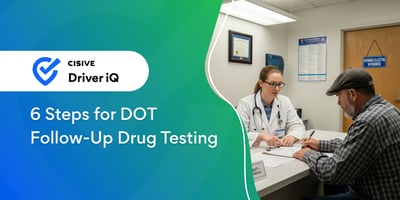
When drivers fail a DOT-mandated drug or alcohol test or refuse to take one, they create...
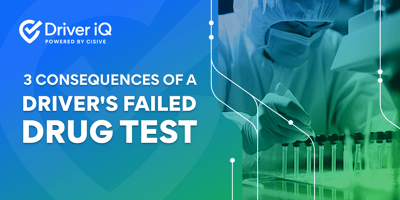
DOT regulations require regular testing of employees in safety-sensitive jobs, including CDL...